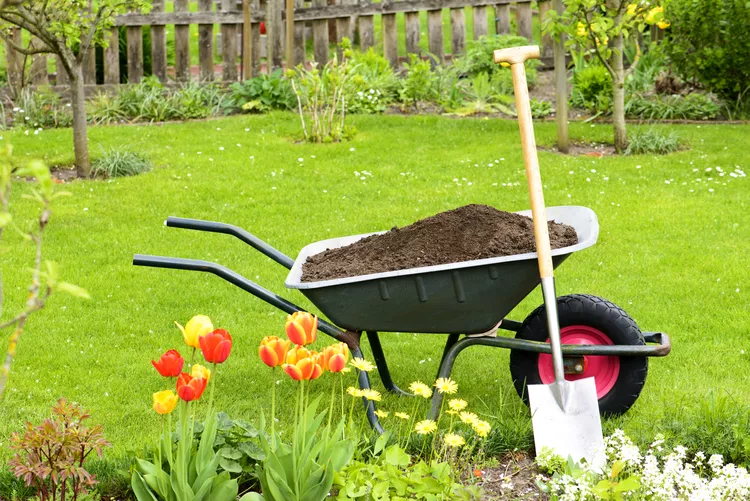Once you've purchased compost or made your own at home, what is compost used for? This versatile garden amendment can enrich soil, improve plant health, smother weeds, and so much more. In the list below, find out how to use compost to achieve all these garden benefits. Whether you have flower beds, a vegetable garden, or just a few potted plants, adding a bit of compost is always a good idea.
1. Improve soil.
One of the most common ways to use compost is as a soil amendment. Compost can be mixed into established flower or vegetable gardens in spring or fall to replenish any nutrients that plants used up during the previous season. Alternatively, compost can be added to new garden beds or areas in your lawn that are too heavy in clay or sand.
To use compost as a soil amendment, spread about 2 to 3 inches of compost across your garden beds and then mix it into the top 6 inches of the soil with a shovel or hand tiller. Not only does compost provide nutrients, but it will increase your soil’s ability to hold moisture and drain efficiently.
2. Use compost as a side or top dressing.
Mixing compost into your soil can be a bit of work, but there's an even easier no-dig gardening solution. Use compost in planting beds as a side dressing or top dressing. Simply spread a thin layer of compost on top of the soil in empty beds in spring or autumn. Then allow the rain to wash the nutrients deep into the soil to your plants’ roots.
Heavy feeding plants and vegetables often benefit from a side dressing of compost during the growing season, too. Just place a few handfuls of aged compost around the base of your plants, making sure the compost doesn’t directly touch the stems. A side dressing of compost can be particularly helpful when applied just before plants set fruit and flowers.
3. Revive potting mix.
The potting mix in your houseplant pots or container gardens can get depleted over time. Plus, frequent watering can compact the mix even further and make it too dense. Mixing compost into your potting mix once or twice a year will refresh old soil and keep your plants thriving for many years to come.
4. Mulch to control weeds.
Bark and straw mulch are commonly used in garden beds to suppress weeds, but compost is another excellent organic mulch option that offers a lot of benefits. Compost mulch usually contains a wider array of nutrients to improve your soil than other types of mulch. The small grain size and consistent coloration of compost also makes an attractive mulch that works equally well in ornamental and vegetable beds.
To use compost as a mulch, spread 1 to 3 inches of compost across your garden in spring or fall. Once in place, compost mulch will inhibit weeds and shield your soil, slowing evaporation rates and conserving soil moisture levels while minimizing erosion.
5. Make compost tea.
Compost can be brewed in water to create compost tea, which can be applied to both indoor and outdoor plants. Effective as both a soil drench and a foliar spray, compost tea can provide nutrients to your plants and help prevent common plant diseases like powdery mildew.
6. Boost new plants.
Give your new annuals, perennials, trees, and bulbs a boost when you plant them by adding some compost. Before backfilling your planting holes, add a little compost to the soil you removed and blend it in well. Adding compost to new plantings can help plants adapt more easily to their new home and it encourages a flush of fresh growth too.
7. Feed your houseplants.
Houseplants can become nutrient deficient as they grow and deplete the nutrients in their potting mix. Blending compost into your potting mix every time you repot your indoor plants can revive lackluster plants and keep them looking their best. For an even easier application, compost tea works well on indoor plants and it can be added to your regular houseplant watering routine.
8. Create a DIY potting mix.
Store-bought potting mixes can be expensive and they may use less eco-friendly ingredients, like peat moss. Instead, you can easily make your own nutrient-rich potting mix to use on houseplants and container gardens. To make your own potting mix, blend together equal parts of compost, vermiculite, and coconut coir.
9. Perk up your lawn.
Spreading 1 to 3 inches of compost across bare soil before planting grass or clover seeds will help your new lawn take root faster. Ideally, this thin layer of compost should be mixed into the top few inches of topsoil but you can seed directly over the layer of compost too.
For established lawns, spread a half-inch layer of finely sifted compost over your grass to provide nutrients and reduce your need for fertilizer. Because compost helps soil hold on to water, adding compost to lawns may also lower your lawn’s watering needs. For an easy application, apply the compost with a broadcast spreader and then rake your lawn gently to make sure the compost is evenly distributed.




















